Genetic Characterization and Breeding Habitats of Black Fly (Diptera, Simuliidae) Vector Species in Laos
Abstract
1. Introduction
2. Materials and Methods
2.1. Specimen Collection and Identification
2.2. Molecular Study
2.3. Data Analysis
3. Results
3.1. Breeding Habitats
3.1.1. Simulium chumpornense
3.1.2. Simulium nodosum
3.2. Genetic Diversity and Genetic Structure
3.2.1. Simulium chumpornense
3.2.2. Simulium nodosum
4. Discussion
4.1. Simulium chumpornense
4.2. Simulium nodosum
Author Contributions
Funding
Institutional Review Board Statement
Data Availability Statement
Acknowledgments
Conflicts of Interest
References
- Mastretta-Yanes, A.; Da Silva, J.M.; Grueber, C.E.; Castillo-Reina, L.; Köppä, V.; Forester, B.R.; Funk, W.C.; Heuertz, M.; Ishihama, F.; Jordan, R.; et al. Multinational evaluation of genetic diversity indicators for the Kunming-Montreal Global Biodiversity Framework. Ecol. Lett. 2024, 27, e14461. [Google Scholar] [CrossRef] [PubMed]
- Powell, J.R. Genetic variation in insect vectors: Death of typology? Insects 2018, 9, 139. [Google Scholar] [CrossRef] [PubMed]
- Hernández-Triana, L.M.; Brugman, V.A.; Nikolova, N.I.; Ruiz-Arrondo, I.; Barrero, E.; Thorne, L.; de Marco, M.F.; Krüger, A.; Lumley, S.; Johnson, N.; et al. DNA barcoding of British mosquitoes (Diptera, Culicidae) to support species identification, discovery of cryptic genetic diversity and monitoring invasive species. ZooKeys 2019, 832, 57–76. [Google Scholar] [CrossRef]
- Rodrigues, B.L.; Carvalho-Costa, L.F.; Pinto, I.D.S.; Rebêlo, J.M.M. DNA barcoding reveals hidden diversity of sand flies (Diptera: Psychodidae) at fine and broad spatial scales in Brazilian endemic regions for leishmaniasis. J. Med. Entomol. 2018, 55, 893–901. [Google Scholar] [CrossRef]
- Jomkumsing, P.; Tangkawanit, U.; Wongpakam, K.; Pramual, P. Who is biting you? DNA barcodes reveal cryptic diversity in human-biting black flies (Diptera: Simuliidae). Acta Trop. 2019, 196, 22–29. [Google Scholar] [CrossRef]
- McCoy, K.D. The population genetic structure of vectors and our understanding of disease epidemiology. Parasite 2008, 15, 444–448. [Google Scholar] [CrossRef]
- Low, V.L.; Adler, P.H.; Sofian-Azirun, M.; Srisuka, W.; Saeung, A.; Huang, Y.T.; Hadi, U.K.; Da Pham, X.; Takaoka, H. Tests of conspecificity for allopatric vectors: Simulium nodosum and Simulium shirakii (Diptera: Simuliidae) in Asia. Parasite Vector 2015, 8, 297. [Google Scholar] [CrossRef]
- Gray, E.W.; Adler, P.H.; Coscaron-Arias, C.; Coscarón, S.; Noblet, R. Development of the first black fly (Diptera: Simuliidae) management program in Argentina and comparison with other programs. J. Am. Mosq. Control Assoc. 1999, 15, 400–406. [Google Scholar]
- Rivers-Moore, N.A.; Hughes, D.A.; De Moor, F.C. A model to predict outbreak periods of the pest blackfly Simulium chutteri Lewis (Simuliidae, Diptera) in the Great Fish River, Eastern Cape Province, South Africa. River Res. Appl. 2008, 24, 132–147. [Google Scholar] [CrossRef]
- Adler, P.H.; Currie, D.C.; Wood, D.M. The Black Flies (Simuliidae) of North America; Cornell University Press: Ithaca, NY, USA, 2004. [Google Scholar]
- Rivera, J.; Currie, D.C. Identification of Nearctic black flies using DNA barcodes (Diptera: Simuliidae). Mol. Ecol. Resour. 2009, 9, 224–236. [Google Scholar] [CrossRef]
- Ruiz-Arrondo, I.; Veiga, J.; Adler, P.H.; Collantes, F.; Oteo, J.A.; Valera, F. Integrated taxonomy of black flies (Diptera: Simuliidae) reveals unexpected diversity in the most arid ecosystem of Europe. PLoS ONE 2023, 18, e0293547. [Google Scholar] [CrossRef] [PubMed]
- Takaoka, H.; Low, V.L.; Tan, T.K.; Ya’cob, Z.; Sofian-Azirun, M.; Dhang Chen, C.; Lau, K.W.; Da Pham, X. A new black fly species of the Simulium (Gomphostilbia) duolongum subgroup (Diptera: Simuliidae) from Vietnam, and molecular comparisons with related species using the COI barcoding gene. J. Med. Entomol. 2019, 56, 432–440. [Google Scholar] [CrossRef]
- Gomontean, B.; Jumpato, W.; Wongpakam, K.; Tangkawanit, U.; Wannasingha, W.; Thanee, I.; Ya’cob, Z.; Pramual, P. Diversity, distribution and host blood meal analysis of adult black flies (Diptera: Simuliidae) from Thailand. Insects 2024, 15, 74. [Google Scholar] [CrossRef] [PubMed]
- Adler, P.H. World Blackflies (Diptera: Simuliidae): A Comprehensive Revision of the Taxonomic and Geographical Inventory [2024]. 2024. Available online: https://biomia.sites.clemson.edu/pdfs/blackflyinventory.pdf (accessed on 31 August 2024).
- Crosskey, R.W. The Natural History of Blackflies; John Wiley & Sons Ltd.: Chichester, UK, 1990. [Google Scholar]
- Adler, P.H.; McCreadie, J.W. Black flies (Simuliidae). In Medical and Veterinary Entomology; Elsevier: San Diego, CA, USA, 2019; pp. 237–259. [Google Scholar]
- Takaoka, H.; Fukuda, M.; Otsuka, Y.; Aoki, C.; Uni, S.; Bain, O. Blackfly vectors of zoonotic onchocerciasis in Japan. Med. Vet. Entomol. 2012, 26, 372–378. [Google Scholar] [CrossRef] [PubMed]
- Takaoka, H.; Srisuka, W.; Saeung, A. Checklist and keys for the black flies (Diptera: Simuliidae) of Thailand. Med. Entomol. Zool. 2019, 70, 53–77. [Google Scholar] [CrossRef]
- Kuvangkadilok, C.; Takaoka, H. Taxonomic notes on Simuliidae (Diptera) from Thailand: Description of a new species and new distributional records of nine known species. Jpn. J. Trop. Med. Hyg. 2000, 28, 167–175. [Google Scholar] [CrossRef]
- Jumpato, W.; Tangkawanit, U.; Wongpakam, K.; Pramual, P. Molecular detection of Leucocytozoon (Apicomplexa: Haemosporida) in black flies (Diptera: Simuliidae) from Thailand. Acta Trop. 2019, 190, 228–234. [Google Scholar] [CrossRef]
- Thaijarern, J.; Tangkawanit, U.; Wongpakam, K.; Pramual, P. Molecular detection of Trypanosoma (Kinetoplastida: Trypanosomatidae) in black flies (Diptera: Simuliidae) from Thailand. Acta Trop. 2019, 200, 105196. [Google Scholar] [CrossRef]
- Pramual, P.; Tangkawanit, U.; Kunprom, C.; Vaisusuk, K.; Chatan, W.; Wongpakam, K.; Thongboonma, S. Seasonal population dynamics and a role as natural vector of Leucocytozoon of black fly, Simulium chumpornense Takaoka & Kuvangkadilok. Acta Trop. 2020, 211, 105617. [Google Scholar]
- Thanee, I.; Jumpato, W.; Jaroenchaiwattanachote, C.; Gomontean, B.; Wannasingha, W.; Namtaku, S.; Adler, P.H.; Pramual, P. Discovery of the larvae and pupae of the black fly Simulium (Gomphostilbia) khelangense and breeding habitats of potential pest species of the S.(G.) chumpornense subgroup (Simuliidae). Insects 2024, 15, 346. [Google Scholar] [CrossRef]
- Pramual, P.; Jomkumsing, P.; Wongpakam, K.; Wongwian, P. DNA barcoding of tropical black flies (Diptera: Simuliidae) in Thailand: One decade of progress. Acta Trop. 2021, 224, 106116. [Google Scholar] [CrossRef] [PubMed]
- Pramual, P.; Jomkumsing, P.; Wathasith, P.; Wongpakam, K. Population structure and population history of the black fly Simulium chumpornense (Diptera: Simuliidae) from Thailand. Acta Trop. 2022, 227, 106301. [Google Scholar] [CrossRef] [PubMed]
- Srisuka, W.; Aupalee, K.; Otsuka, Y.; Fukuda, M.; Takaoka, H.; Saeung, A. A new species of Simulium (Gomphostilbia) (Diptera, Simuliidae) from Thailand, with a key to identify females of 14 species of the Simulium varicorne species-group. ZooKeys 2022, 1083, 1–12. [Google Scholar] [CrossRef] [PubMed]
- Puri, I.M. Studies on Indian Simuliidae. Part VII. Descriptions of larva, pupa and female of Simulium nodosum sp. nov., with an appendix dealing with S. novolineatum nov. nom. (=S. lineatum Puri). Ind. J. Med. Res. 1933, 20, 813–817. [Google Scholar]
- Datta, M. An overview of the Simuliidae (Diptera) of West Bengal. India J. Bengal Nat. Hist. Soc. 1992, 11, 41–62. [Google Scholar]
- Takaoka, H.; Choochote, W.; Aoki, C.; Fukuda, M.; Bain, O. Black flies (Diptera: Simuliidae) attracted to humans and water buffalos and natural infections with filarial larvae, probably Onchocerca sp., in northern Thailand. Parasite 2003, 10, 3–8. [Google Scholar] [CrossRef][Green Version]
- Choochote, W.; Takaoka, H.; Fukuda, M.; Otsuka, Y.; Aoki, C.; Eshima, N. Seasonal abundance and daily flying activity of black flies (Diptera: Simuliidae) attracted to human baits in Doi Inthanon National Park, northern Thailand. Med. Entomol. Zool. 2005, 56, 335–348. [Google Scholar] [CrossRef]
- Tangkawanit, U.; Kuvangkadilok, C.; Trinachartvanit, W.; Baimai, V. Cytotaxonomy, morphology and ecology of the Simulium nobile species group (Diptera: Simuliidae) in Thailand. Cytogenet. Genome Res. 2011, 134, 308–318. [Google Scholar] [CrossRef]
- Srisuka, W.; Takaoka, H.; Otsuka, Y.; Fukuda, M.; Thongsahuan, S.; Taai, K.; Choochote, W.; Saeung, A. Seasonal biodiversity of black flies (Diptera: Simuliidae) and evaluation of ecological factors influencing species distribution at Doi Pha Hom Pok National Park, Thailand. Acta Trop. 2015, 149, 212–219. [Google Scholar] [CrossRef]
- Jitklang, S.; Sawangproh, W.; Kuvangkadilok, C.; Baimai, V.; Adler, P.H. Ecology of black flies (Diptera: Simuliidae) in streams of northern and southern Thailand: Factors associated with larval and pupal distributions. Acta Trop. 2020, 204, 105357. [Google Scholar] [CrossRef]
- Chaiyasan, P.; Pramual, P. Population genetic structure and demographic history of the black fly vector, Simulium nodosum in Thailand. Med. Vet. Entomol. 2016, 30, 286–292. [Google Scholar] [CrossRef] [PubMed]
- Pramual, P.; Kuvangkadilok, C. Agricultural land use and black fly (Diptera, Simuliidae) species richness and species assemblages in tropical streams, Northeastern Thailand. Hydrobiologia 2009, 625, 173–184. [Google Scholar] [CrossRef]
- McCreadie, J.W.; Adler, P.H.; Grillet, M.E.; Hamada, N. Sampling statistics in understanding distributions of black fly larvae (Diptera: Simuliidae). Acta Entomol. Serbica 2006, 11, 89–96. [Google Scholar]
- Takaoka, H.; Sofian-Azirun, M.; Ya’Cob, Z.; Chen, C.D.; Lau, K.W.; Low, V.L.; Da Pham, X.; Adler, P.H. The black flies (Diptera: Simuliidae) of Vietnam. Zootaxa 2017, 4261, 1–165. [Google Scholar] [CrossRef]
- Folmer, O.; Hoeh, W.R.; Black, M.B.; Vrijenhoek, R.C. Conserved primers for PCR amplification of mitochondrial DNA from different invertebrate phyla. Mol. Marine Biol. Biotechnol. 1994, 3, 294–299. [Google Scholar]
- Tangkawanit, U.; Wongpakam, K.; Pramual, P. A new black fly (Diptera: Simuliidae) species of the subgenus Asiosimulium Takaoka Choochote from Thailand. Zootaxa 2018, 4388, 111–122. [Google Scholar] [CrossRef]
- Meier, R.; Shiyang, K.; Vaidya, G.; Ng, P.K. DNA barcoding and taxonomy in Diptera: A tale of high intraspecific variability and low identification success. Syst. Biol. 2006, 55, 715–728. [Google Scholar] [CrossRef]
- Excoffier, L.; Lischer, H.E. Arlequin suite ver 3.5: A new series of programs to perform population genetics analyses under Linux and Windows. Mol. Ecol. Resour. 2010, 10, 564–567. [Google Scholar] [CrossRef]
- Bandelt, H.J.; Forster, P.; Röhl, A. Median-joining networks for inferring intraspecific phylogenies. Mol. Biol. Evol. 1999, 16, 37–48. [Google Scholar] [CrossRef]
- Rogers, A.R.; Harpending, H. Population growth makes waves in the distribution of pairwise genetic differences. Mol. Biol. Evol. 1992, 9, 552–569. [Google Scholar]
- Harpending, H.C. Signature of ancient population growth in a low-resolution mitochondrial DNA mismatch distribution. Hum. Biol. 1994, 66, 591–600. [Google Scholar] [PubMed]
- Tajima, F. Statistical method for testing the neutral mutation hypothesis by DNA polymorphism. Genetics 1989, 123, 585–595. [Google Scholar] [CrossRef] [PubMed]
- Fu, Y.X. Statistical tests of neutrality of mutations against population growth, hitchhiking and background selection. Genetics 1997, 147, 915–925. [Google Scholar] [CrossRef]
- Papadopoulou, A.; Anastasiou, I.; Vogler, A.P. Revisiting the insect mitochondrial molecular clock: The mid-Aegean trench calibration. Mol. Biol. Evol. 2010, 27, 1659–1672. [Google Scholar] [CrossRef]
- Pramual, P.; Kuvangkadilok, C.; Baimai, V.; Walton, C. Phylogeography of the black fly Simulium tani (Diptera: Simuliidae) from Thailand as inferred from mtDNA sequences. Mol. Ecol. 2005, 14, 3989–4001. [Google Scholar] [CrossRef]
- Hew, Y.X.; Ya’cob, Z.; Chen, C.D.; Lau, K.W.; Sofian-Azirun, M.; Muhammad-Rasul, A.H.; Putt, Q.Y.; Tan, T.K.; Hadi, U.K.; Suana, I.W.; et al. Co-occurrence of dual lineages within Simulium (Gomphostilbia) atratum De Meijere in the Indonesian Archipelago along Wallace’s Line. Acta Trop. 2024, 250, 107097. [Google Scholar] [CrossRef]
- Kunprom, C.; Sopaladawan, P.N.; Pramual, P. Population genetics and demographic history of guava fruit fly Bactrocera correcta (Diptera: Tephritidae) in northeastern Thailand. Eur. J. Entomol. 2015, 112, 227–234. [Google Scholar] [CrossRef]
- O’loughlin, S.M.; Okabayashi, T.; Honda, M.; Kitazoe, Y.; Kishino, H.; Somboon, P.; Sochantha, T.; Nambanya, S.; Saikia, P.K.; Dev, V.; et al. Complex population history of two Anopheles dirus mosquito species in Southeast Asia suggests the influence of Pleistocene climate change rather than human-mediated effects. J. Evol. Biol. 2008, 21, 555–1569. [Google Scholar] [CrossRef]
- Morgan, K.; O’loughlin, S.M.; Chen, B.; Linton, Y.; Thongwat, D.; Somboon, P.; Fong, M.Y.; Butlin, R.; Verity, R.; Prakash, A.; et al. Comparative phylogeography reveals a shared impact of Pleistocene environmental change in shaping genetic diversity within nine Anopheles mosquito species across the Indo-Burma biodiversity hotspot. Mol. Ecol. 2011, 20, 4533–4549. [Google Scholar] [CrossRef]
- Low, V.L.; Norma-Rashid, Y.; Yusoff, A.; Vinnie-Siow, W.Y.; Prakash, B.K.; Tan, T.K.; Noorhidayah, M.; Chen, C.D.; Sofian-Azirun, M. Pleistocene demographic expansion and high gene flow in the Globe Skimmer dragonfly Pantala flavescens Fabricius (Odonata: Libellulidae) in Peninsular Malaysia. Zool. Anz. 2017, 266, 23–27. [Google Scholar] [CrossRef]
- Adler, P.H.; Kúdelová, T.; Kúdela, M.; Seitz, G.; Ignjatović-Ćupina, A. Cryptic biodiversity and the origins of pest status revealed in the macrogenome of Simulium colombaschense (Diptera: Simuliidae), history’s most destructive black fly. PLoS ONE 2016, 11, e0147673. [Google Scholar] [CrossRef] [PubMed]
- Pramual, P.; Thaijarern, J.; Wongpakam, K. DNA barcoding of human-biting black flies (Diptera: Simuliidae) in Thailand. Acta Trop. 2016, 164, 33–40. [Google Scholar] [CrossRef] [PubMed]
- Putt, Q.Y.; Ya’cob, Z.; Adler, P.H.; Chen, C.D.; Hew, Y.X.; Izwan-Anas, N.; Lau, K.W.; Sofian-Azirun, M.; Pham, X.D.; Takaoka, H.; et al. From bites to barcodes: Uncovering the hidden diversity of black flies (Diptera: Simuliidae) in Vietnam. Parasite Vector 2023, 16, 266. [Google Scholar] [CrossRef] [PubMed]
- Ya’cob, Z.; Takaoka, H.; Low, V.L.; Sofian-Azirun, M. First description of a new cryptic species, Simulium vanluni from Peninsular Malaysia: An integrated morpho-taxonomical and genetic approach for naming cryptic species in the family Simuliidae. Acta Trop. 2017, 167, 31–39. [Google Scholar] [CrossRef]
- Hausdorf, B.; Hennig, C. Species delimitation and geography. Mol. Ecol. Resour. 2020, 20, 950–960. [Google Scholar] [CrossRef]
- Bellwood, P. The origins and dispersals of agricultural communities in Southeast Asia. In Southeast Asia: From Prehistory to History. I; Routledge Curzon: London, UK, 2004; pp. 21–40. [Google Scholar]
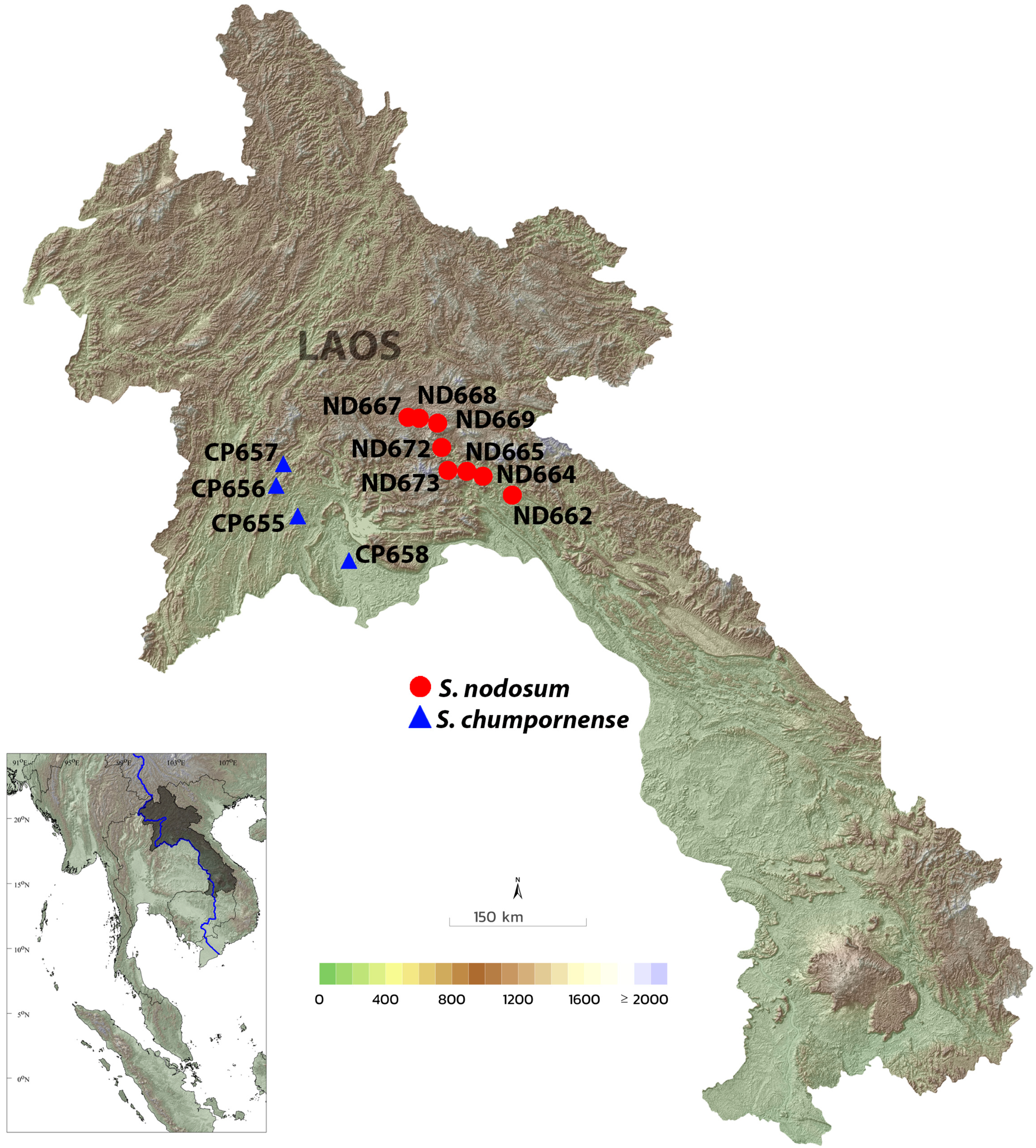
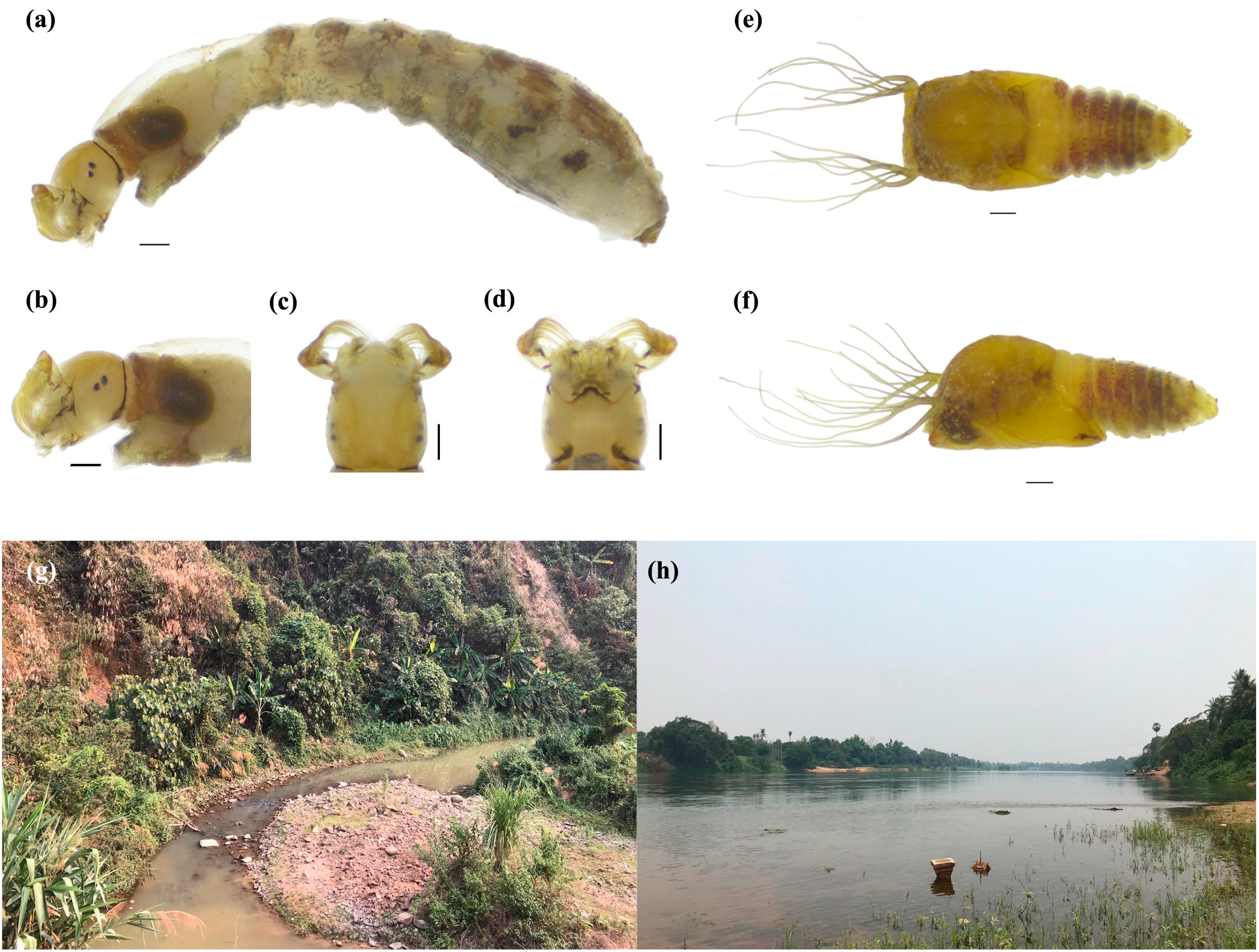

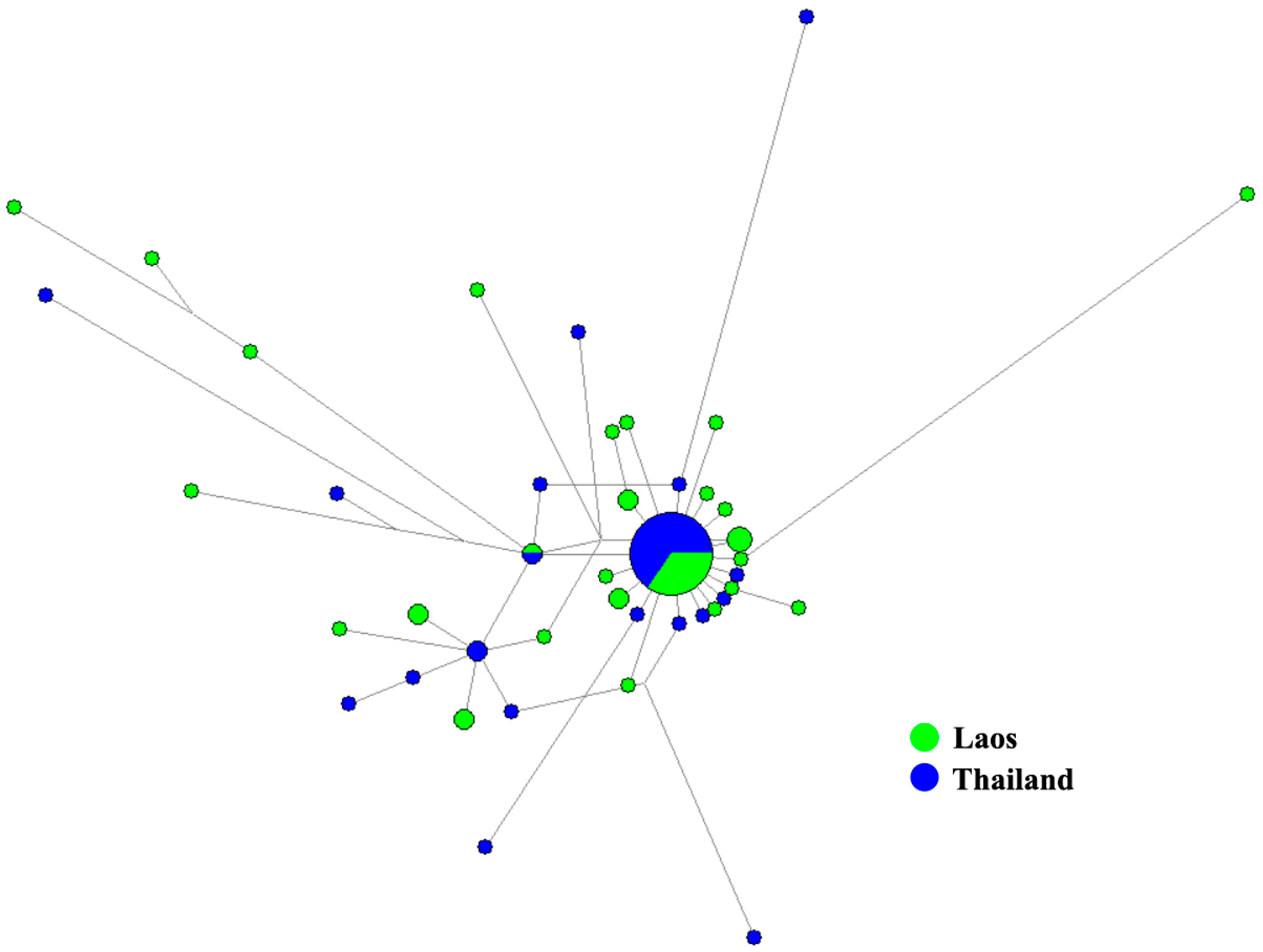
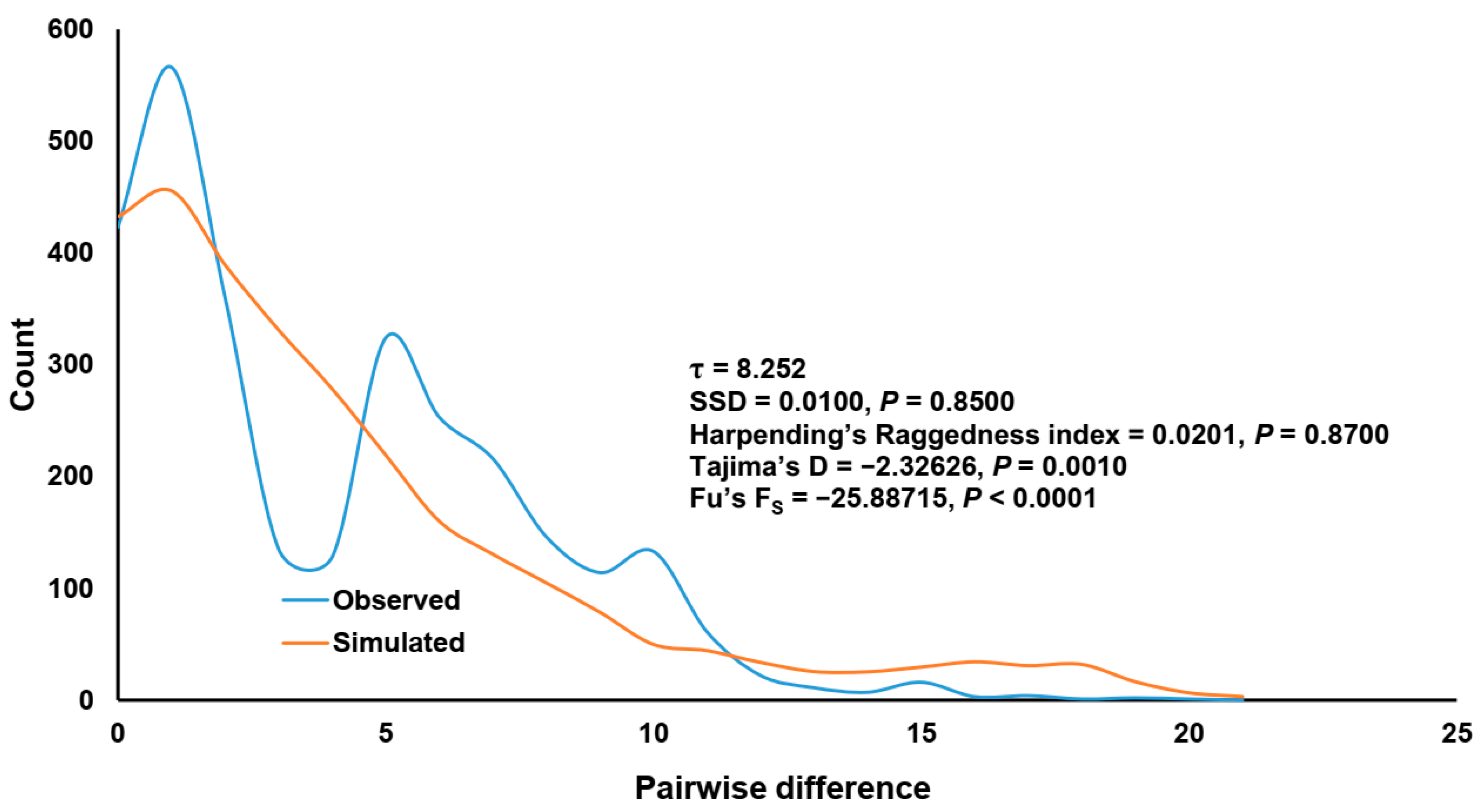
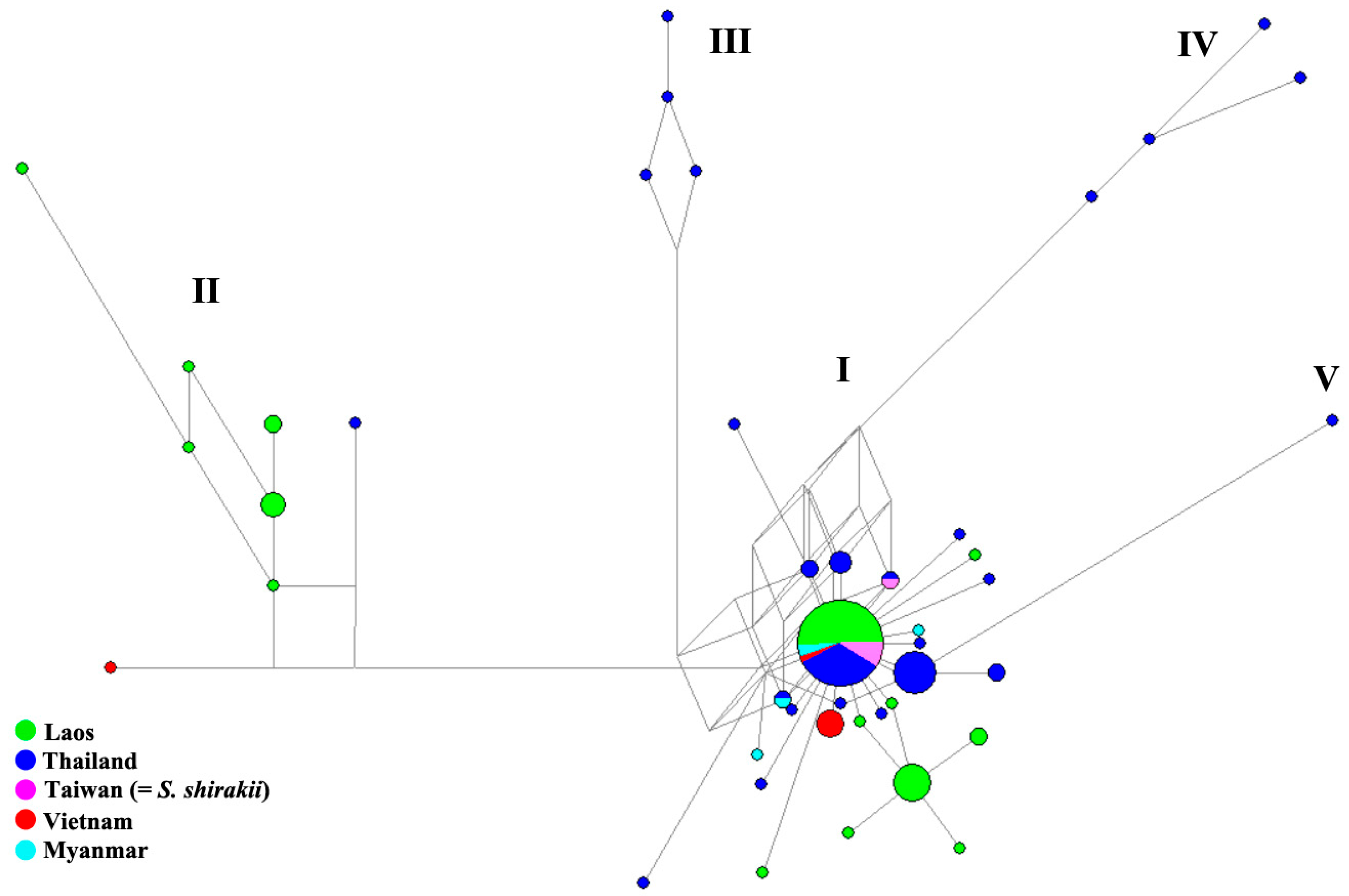
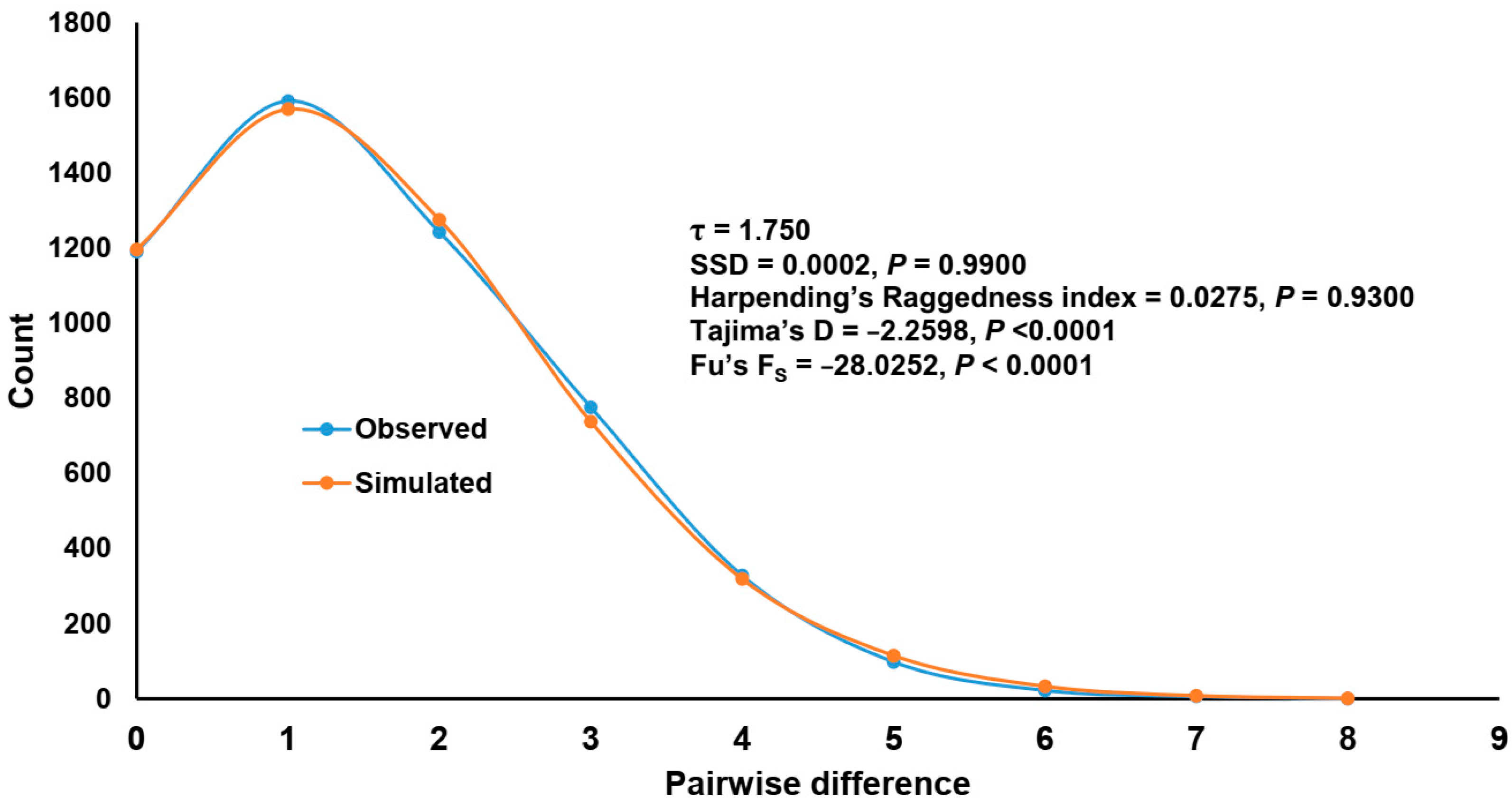
| Species/Location (Code) | n Collected (n Molecular Study) | Coordinate | Collection Date | Haplotype | h ± SD | π ± SD |
|---|---|---|---|---|---|---|
| S. chumpornense | ||||||
| Huay Kang Chang, Vientiane Province (CP655) | 30 (8) | 18.634328, 102.227883 | 27 April 2024 | 8 | 1.0000 ± 0.0625 | 0.0121 ± 0.0071 |
| Pha Thor Nor Kham, Vientiane Province (CP656) | 106 (9) | 18.69991, 102.125136 | 27 April 2024 | 7 | 0.9444 ± 0.0702 | 0.0056 ± 0.0036 |
| Meuang Feuang, Vientiane Province (CP657) | 2 (-) | 18.72118, 102.132592 | 27 April 2024 | - | - | - |
| Nam Ngum River, Vientiane Province (CP658) | 79 (22) | 18.362722, 102.571852 | 28 April 2024 | 13 | 0.8961 ± 0.0550 | 0.0064 ± 0.0037 |
| Total for S. chumpornense | 217 (39) | 25 | 0.9312 ± 0.0325 | 0.0075 ± 0.0042 | ||
| S. nodosum | ||||||
| Ban Tha Si, Xaisomboun Province (ND662) | 1 (-) | 18.847473, 103.811762 | 2 June 2024 | - | - | - |
| Thathom, Xaisomboun Province, (ND664) | 7 (-) | 19.018073, 103.571765 | 2 June 2024 | - | - | - |
| Nam Long, Meuang Thathom, Xaisomboun Province (ND665) | 194 (12) | 19.039968, 103.492550 | 2 June 2024 | 6 | 0.7576 ± 0.1221 | 0.0104 ± 0.0060 |
| Muang Khoune 1, Xiang Khoang Province (ND667) | 164 (9) | 19.374480, 103.246903 | 3 June 2024 | 4 | 0.7500 ± 0.1121 | 0.0061 ± 0.0039 |
| Nam Kay, Muang Khoune, Xiang Khoang Province (ND668) | 16 (5) | 19.365400, 103.281977 | 3 June 2024 | 4 | 0.9000 ± 0.1610 | 0.0146 ± 0.0095 |
| Nam Ngiou, Muang Khoune, Xiang Khoang Province (ND669) | 14 (6) | 19.340172, 103.365443 | 3 June 2024 | 2 | 0.5333 ± 0.1721 | 0.0018 ± 0.0016 |
| Muang Khoune 2, Xiang Khoang Province (ND672) | 27 (9) | 19.199450, 103.352790 | 3 June 2024 | 5 | 0.8056 ± 0.1196 | 0.0039 ± 0.0027 |
| Nam Toun, Muang Thathom, Xaisomboun Province (ND673) | 228 (11) | 19.037032, 103.407447 | 3 June 2024 | 5 | 0.7818 ± 0.0926 | 0.0085 ± 0.0050 |
| Total for S. nodosum | 651 (52) | 16 | 0.7587 ± 0.0553 | 0.0082 ± 0.0045 |
| Species/ Location Code | N (Larva/Pupa) | Elevation (m) | Width (m) | Depth (m) | Velocity (m/s) | Water Conductivity (µS/cm2) | pH | Water Temperature (°C) | Streambed Particles | Canopy Covered | Riparian Vegetation |
|---|---|---|---|---|---|---|---|---|---|---|---|
| S. chumpornense | |||||||||||
| CP655 | 30 (17/13) | 210 | 5.0 | 0.30 | 0.44 | 116 | 7.96 | 30.9 | boulder | open | open |
| CP656 | 106 (106/-) | 220 | 10 | 0.25 | 1.01 | 301 | 8.12 | 30.8 | rubble | open | brush |
| CP657 | 2 (2/-) | 220 | 1 | 0.60 | 0.90 | 175 | 7.18 | 26.8 | rubble | open | open |
| CP658 | 79 (41/38) | 159 | 290 | 0.20 | 0.56 | 113 | 7.20 | 27.32 | small stone | open | open |
| S. nodosum | |||||||||||
| ND662 | 1 (1/-) | 209 | 30 | 0.40 | 0.78 | 40 | 7.41 | 25.6 | boulder | open | open |
| ND664 | 7 (7/-) | 281 | 1 | 0.12 | 0.44 | 120 | 7.90 | 30.0 | rubble | partial | brush |
| ND665 | 194 (187/7) | 358 | 10 | 0.30 | 0.63 | 125 | 7.70 | 28.0 | boulder | open | brush |
| ND667 | 164 (153/11) | 1146 | 1 | 0.10 | 0.62 | 422 | 7.7 | 24.5 | boulder | open | open |
| ND668 | 16 (11/5) | 1118 | 2 | 0.06 | 0.40 | 283 | 7.5 | 25.0 | small stone | open | open |
| ND669 | 14 (5/9) | 1072 | 2 | 0.17 | 0.78 | 160 | 7.5 | 26.0 | sand | open | open |
| ND672 | 27 (24/3) | 719 | 5 | 0.30 | 1.31 | 69 | 7.7 | 27.4 | boulder | open | open |
| ND673 | 228 (210/18) | 325 | 5 | 0.24 | 0.79 | 139 | 7.8 | 28.6 | boulder | open | open |
| Population | CP655 | CP656 | CP658 |
|---|---|---|---|
| CP655 | - | ||
| CP656 | −0.02029 | - | |
| CP658 | 0.06934 | 0.03463 | - |
| Population | ND665 | ND667 | ND668 | ND669 | ND672 | ND673 |
|---|---|---|---|---|---|---|
| ND665 | - | |||||
| ND667 | 0.06487 | - | ||||
| ND668 | −0.01285 | 0.19299 | - | |||
| ND669 | 0.16224 | −0.08807 | 0.35267 | - | ||
| ND672 | 0.19839 | −0.02560 | 0.37530 | −0.09251 | - | |
| ND673 | 0.05450 | −0.07906 | 0.09903 | −0.00043 | 0.04840 | - |
Disclaimer/Publisher’s Note: The statements, opinions and data contained in all publications are solely those of the individual author(s) and contributor(s) and not of MDPI and/or the editor(s). MDPI and/or the editor(s) disclaim responsibility for any injury to people or property resulting from any ideas, methods, instructions or products referred to in the content. |
© 2024 by the authors. Licensee MDPI, Basel, Switzerland. This article is an open access article distributed under the terms and conditions of the Creative Commons Attribution (CC BY) license (https://creativecommons.org/licenses/by/4.0/).
Share and Cite
Thanee, I.; Gomontean, B.; Jumpato, W.; Namtaku, S.; Wongpakam, K.; Wannasingha, W.; Inkhavilay, K.; Malavong, B.; Pramual, P. Genetic Characterization and Breeding Habitats of Black Fly (Diptera, Simuliidae) Vector Species in Laos. Diversity 2024, 16, 653. https://doi.org/10.3390/d16110653
Thanee I, Gomontean B, Jumpato W, Namtaku S, Wongpakam K, Wannasingha W, Inkhavilay K, Malavong B, Pramual P. Genetic Characterization and Breeding Habitats of Black Fly (Diptera, Simuliidae) Vector Species in Laos. Diversity. 2024; 16(11):653. https://doi.org/10.3390/d16110653
Chicago/Turabian StyleThanee, Isara, Bhuvadol Gomontean, Waraporn Jumpato, San Namtaku, Komgrit Wongpakam, Wannachai Wannasingha, Khamla Inkhavilay, Banchai Malavong, and Pairot Pramual. 2024. "Genetic Characterization and Breeding Habitats of Black Fly (Diptera, Simuliidae) Vector Species in Laos" Diversity 16, no. 11: 653. https://doi.org/10.3390/d16110653
APA StyleThanee, I., Gomontean, B., Jumpato, W., Namtaku, S., Wongpakam, K., Wannasingha, W., Inkhavilay, K., Malavong, B., & Pramual, P. (2024). Genetic Characterization and Breeding Habitats of Black Fly (Diptera, Simuliidae) Vector Species in Laos. Diversity, 16(11), 653. https://doi.org/10.3390/d16110653






